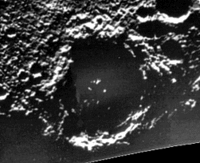- Chao Meng-Fu (crater)
-
Chao Meng-Fu (crater) 
Chao Meng-Fu craterPlanet Mercury Coordinates 87°18′S 132°24′W / 87.3°S 132.4°WCoordinates: 87°18′S 132°24′W / 87.3°S 132.4°W Diameter 167 km Eponym Zhao Mengfu Chao Meng-Fu is a 167 kilometer-diameter crater on Mercury named after the Chinese painter and calligrapher Zhao Mengfu (1254 - 1322). Due to its location near Mercury's south pole (132.4° west, 87.3° south) and the planet's small axial tilt, an estimated 40%[1] of the crater lies in permanent shadow. This combined with bright radar echoes from the location of the crater leads scientists to suspect that it may shelter large quantities of ice protected against sublimation into the near-vacuum by the constant -171°C temperatures.
Contents
Radar evidence for ice
Radar studies involving Arecibo (Puerto Rico), Goldstone (California, United States), and the Very Large Array (New Mexico, United States) detected a number of highly-radar-reflective depolarized areas on Mercury, including several locations at the planet's poles. Many of these reflective features appear to coincide with craters imaged by Mariner 10, with the largest feature at the south pole corresponding to Chao Meng-Fu crater.[2][3]
The luminosity and depolarization of the radar reflections are much more characteristic of ice than of the silicate rocks making up Mercury's crust. Still, these reflections are too dim to be pure ice; it has been hypothesized that this is due to a thin or partial layer of powder over the underlying ice. However, with no direct confirmation, it is always possible that the observed radar reflectivity from Chao Meng-Fu and similar craters is due to depositions of metal-rich minerals and compounds. NASA's MESSENGER mission may provide additional evidence for or against the presence of ice when it begins orbiting Mercury in 2011.Ice origins
Chao Meng-Fu's ice may have originated from impacts of water-rich meteorites and comets or from internal outgassing. Due to bombardment by the solar wind and intense light from the Sun, ice deposits on most of Mercury would be rapidly lost to space; in the permanently shadowed portions of Chao Meng-Fu, though, temperatures are too low to permit appreciable sublimation and ice may well have accumulated over billions of years.
Chao Meng-Fu crater in fiction
A geothermally heated ocean beneath Chao Meng-Fu crater serves as the home of an alien species in Stephen Baxter's Vacuum Diagrams.
Gerald Nordley's short story "Crossing Chao Meng-Fu" depicts rock-climbers struggling to traverse the crater.
Mark Anson's novel Below Mercury[4] is set in an abandoned ice mine below Chao Meng-fu crater.
References
- ^ James Salvail, Fraser Fanale (1994). "Near-surface ice on Mercury and the Moon". Icarus 111 (2): 441–455. Bibcode 1994Icar..111..441S. doi:10.1006/icar.1994.1155.
- ^ L. J. Harcke et al. (2001). "Radar Imaging of Mercury's North and South Poles at 3.5 cm Wavelength". Workshop on Mercury: Space Environment, Surface, and Interior: 36. http://www.lpi.usra.edu/meetings/mercury01/pdf/8032.pdf.
- ^ J. K. Harmon et al. (1994). "Radar mapping of Mercury's polar anomalies". Nature 369 (6477): 213–215. Bibcode 1994Natur.369..213H. doi:10.1038/369213a0.
- ^ Anson, Mark. Below Mercury. Glenn Field Publishing, 2011. ISBN 978-0-9568898-0-5
See also
External links
- Radar Imaging of Mercury's North and South Poles at 3.5 cm Wavelength contains radar images, including one showing the bright reflection from Chao Meng-Fu crater.
Mercury Observation 
Transits Exploration Properties Geology - Beagle Rupes
- Caloris Basin
- Discovery Rupes
- Rembrandt Basin
- Resolution Rupes
Other topics Categories:- Bach quadrangle
- Impact craters on Mercury
Wikimedia Foundation. 2010.
